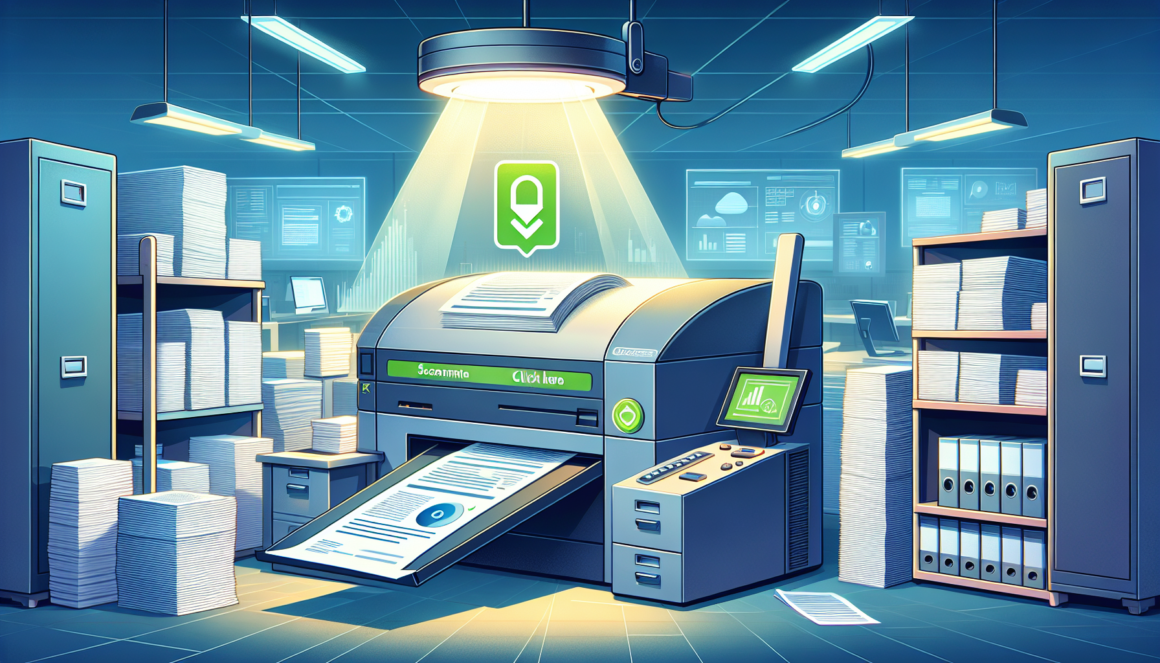The importance of pre-planning
Digital transformation is a crucial step for any company seeking to optimize its internal processes and ensure better data management. The advent of digital has disrupted traditional working methods, and the document scanning now occupies a central place in this revolution.
Analyze your Needs and Objectives
Careful planning is the key to a successful transition to digitization effective use of your documentary heritage. Before starting this digital journey, a complete audit of your company’s needs and objectives is essential. It is not just a question of converting paper documents into electronic format, but rather of engaging in strategic thinking: Which documents have priority? What will be the purpose of the document once digitized?
Choice of Tools and Technological Solutions
According to the Global Education Monitoring Report 2023, entitled “Technology in education: who is in charge?”, it is crucial to carefully select technological tools to carry out education and training projects. . In the same way, for the document scanning, selecting the right technologies will have a direct impact on the success of your project. From enterprise document management solutions to high-performance professional scanners, every choice should be guided by a thorough understanding of your operational objectives and constraints.
Implementation of Information Governance
Any digitalization strategy must be accompanied by effective information governance. This involves creating clear policies regarding the handling, storage and security of digitized data. Regulatory compliance and privacy issues should be anticipated, and procedures should be established to manage information throughout its lifecycle.
Training and Support of Teams
The success of digitalization also requires the support of your employees. Training and support for teams is therefore essential. It is important to familiarize them with the new tools, make them aware of good practices in digital document management, and involve them in the change.
Performance Measurement and Adjustments
Finally, establishing a performance monitoring system from the start of the digitization project allows you to evaluate its impact and make adjustments if necessary. Relevant performance indicators will help measure the effectiveness of the process and ensure its continuous improvement.
digitization successful, an undeniable asset for the sustainability and agility of your business.
Choice of tools and software suitable for digitization

Digital transformation involves systematic conversion of physical documents into digital data. For businesses, particularly in the field of Construction, this means digitalizing administrative processes to gain efficiency and competitiveness. However, given the multitude of options available, identifying the appropriate tools and software can be complex.
Define Your Specific Digitization Needs
Before any purchase, it is essential to identify the specific needs of your business. For a construction company, site management is crucial. Thus, choosing suitable site management software can transform project coordination and internal communication. Each solution, whether it is a billing software or a 3D modeling tool (such as the 13 free 3D modeling tools available online), must be evaluated according to its adaptability and its ability to comply with the different constraints of the sector.
Software Selection Criteria
Once the needs are specified, the selection criteria become clearer. Issues such as compatibility with existing systems and ease of use are decisive. Solutions such as construction site management software, which offer a wide choice for companies, can considerably improve the daily lives of construction professionals. Furthermore, the dematerialization of business documents requires an innovative approach (exploration of innovative approaches to dematerialization) and a thorough understanding of the latest technological developments.
Choosing the Appropriate Scanning Equipment
Scanning quality also relies heavily on the hardware used. High-quality peripherals like scanners are essential to achieve professional results. You should choose a scanner suitable for your digitization project, taking into account aspects such as scanning speed, resolution and power capacity (guide to choosing scanners). For quick notes and document management in the field, acquiring a digital notepad modern can be a wise choice (list of the best models at the start of 2023).
Accessibility and Support for All
Digital inclusion is also an important consideration, especially at a time whenschool and workplaces are seeking to be more accessible (use of digital technology in education). The software chosen must be capable of supporting adaptive features to support users with special needs, such as people with dys (technological aids and dys disorders). The ability of digital tools to adapt to different constraints is essential for a company that truly wishes to digitize its administrative processes.
Evaluate and Test Before Implementation
Finally, before proceeding with the complete acquisition of software or a scanning device, it is advisable to conduct extensive tests and evaluate feedback from potential users within the company. Software can be efficient in theory, but if its daily use proves complex, it will not meet the needs of the personnel concerned. Consider seeking professional opinions in specialized articles or forums to refine your decision-making.
With these guidelines, choosing the right tools and software for document digitization becomes a thoughtful and structured process. This ensures that the investments you make today will pay off in the long term. Stay focused on solutions that promote productivity, inclusiveness and innovation for successful and advantageous digitalization.
Define an efficient workflow for document processing

In today’s business climate, where efficiency and speed are the lifeblood of businesses, workflow optimization is essential. In terms of document processing, establishing an efficient scanning workflow is not a convenience, but a necessity. How, then, can we automate the process and ensure that each document is processed accurately and quickly?
Automating Document Validation
Automation is the keystone of a harmonious and efficient work environment. When it comes to document validation, it is crucial to integrate systems that support this in a systematic manner. Solutions exist to guide documents through various validation stages, based on pre-established rules and defined approval thresholds. This not only speeds up the process but also reduces human errors.
Essential Features of EDM Software for Businesses
When we talk about electronic document management software (GED), several features are essential for a company that wants to remain competitive. Advanced indexing for quick access, versioning to track the evolution of a document, or even real-time collaboration are just a few examples of the tools that must be included in a robust and scalable EDM platform.
The Best EDM Software in 2024
With the constant rise of new technologies, the EDM software landscape continues to evolve. To stay ahead of the curve, stay informed about best EDM software is essential. Choosing a tool suited to your specific needs may seem confusing, but it is a decisive step in establishing a successful scanning workflow. Selecting software depends on many factors, including the features offered, ease of integration with existing systems, and quality of tracking and support.
Establishing a Suitable Digitization Workflow
A scanning workflow is not a one-size-fits-all solution; it must be tailor-made, based on the specificities of each company. It starts with a in-depth needs analysis, followed by the selection of an EDM platform and scanning devices adapted to your document volume. The next step is to clearly define the stages of document processing: from capture to classification, indexing, validation, and finally archiving or destruction.
The Importance of Good After-Sales Service
In adopting document processing technology, we cannot ignore the importance of competent after-sales service. From software updates to hardware troubleshooting, the quality of technical support directly impacts the continuity of the established workflow.
In conclusion, designing an effective workflow for digital document processing is not just a matter of tools, but also of strategy, adaptability and constant support. With one eye on the present and the other on the future, every company can build a system where information flows unhindered, strengthening its ability to make informed and rapid decisions.
The impact of original quality on the digitization process

In our digital age, document digitization has become a necessity to access, share and store information efficiently. However, the original quality of the documents plays a crucial role in this process. Poor quality can compromise not only accessibility but also the integrity of digitized data. Investing in high-precision digitization practices not only better preserves information but also facilitates its subsequent processing.
Authenticity and Compliance : These aspects prove crucial when it comes to processing official documents requiring electronic signature. The challenges surrounding legal admissibility indicated on MyInfo emphasize the importance of ensuring that the digitization faithfully reflects the original, without alteration that could affect their legal validity.
Quality of the Original : The sharpness, cleanliness and resolution of the documents before scanning are decisive. Blurry text or a smeared image can cause character recognition (OCR) software to misinterpret it, causing errors in digital archives. Reports such as Global Education Monitoring Report, 2023, exhibited on UNESCO, illustrate how the clarity of educational materials directly influences the absorption of information and the quality of learning.
Archiving and Respect of Data : The Departmental House for Disabled People (MDPH), as detailed in Archimag, highlights the care taken in digitizing and archiving files while scrupulously respecting health data. Optimal original quality is fundamental to ensuring the security and confidentiality of digitized records.
In the context of learning, the advances described by the future humanists of learning and the UNITWIN networks show how the match between the quality of educational documents and digitization methods supports the evolution of a resolutely modern pedagogy, as evidenced by the discussions on UNESCO.
To summarize, impeccable original quality is the cornerstone of effective digitization, ensuring accuracy, compliance and proper preservation of information. High-quality digitization not only ensures the longevity of documents but also greatly facilitates their accessibility and use in our increasingly digital world.
Secure digital storage and archiving management
With the rise of digital transformation, the major challenge for companies is to guarantee the security and optimal storage of their digitized data. L’digital archiving is not just a question of physical clearance, it is a complete strategy which aims to facilitate access to documents, while preserving them from any risk of loss or cyberattack.
Scanning and security must move hand in hand. Document scanning involves converting paper documents into electronic format. It is therefore crucial to secure this often sensitive information as soon as it enters the digital world. For this, several tools and methodologies should be favored to ensure long-term and secure conservation of this digital heritage.
Tools to consider for secure storage
To address the issue of secure storage, it is necessary to equip your business with 3 essential tools. Indeed, using cloud storage platforms with advanced security protocols is a first step. These services not only offer scalable storage space but also ensure, through encryption measures, that only authorized users have access to the documents.
Data Management Platforms (DMPs), which allow data to be structured and analyzed, also play a fundamental role. They are complemented by electronic document management (EDM) systems to ensure rational organization of digital archives. These tools together form an almost impenetrable armor against intrusions and data loss.
Deciphering the terms of dematerialization
Understanding the jargon is essential to mastering the security and optimization of your scanning processes. A glossary of dematerialization in 10 key words explains key concepts, including ‘encryption’, ‘electronic signature’, ‘cloud computing’, and ‘interoperability’. These terms embody the foundations on which the integrity of your digital archives rests.
The benefits of digital archiving for businesses
But why take the step of digital archiving? The reasons are numerous and all converge towards one operational efficiency increased. By opting for thedigital archiving, your business gains a flexible solution that adapts to fluctuating document volumes, while reducing costs related to physical storage.
Not only does it ensure rapid data recovery in the event of an audit or legal need, but it also helps protect the environment by reducing paper consumption. Furthermore, digital archiving facilitates information sharing and collaboration, aspects that have become essential in the context of hybrid work.
In conclusion, theoptimization of storage and secure digital archiving constitutes an important lever to strengthen the competitiveness and sustainability of your company. Integrating these practices into your digital strategy ensures a peaceful and efficient future for your document management. Discerning the path to successful digitization and digital archiving can begin with the discovery and implementation of these fundamental elements.


Leave a Reply